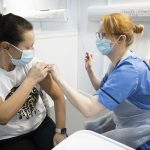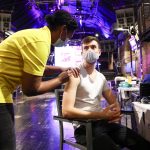Lateral flow tests are more accurate in detecting COVID-19 than previously reported, researchers at University College London have found.
The peer-reviewed paper, published on Thursday in Clinical Epidemiology, found that the tests will detect most people at risk of transmitting COVID-19.
The report also said the tests are a reliable public health tool in stopping the spread of the virus.
Lateral flow tests ‘far more effective than previously thought’ – COVID latest
The researchers used a new formula to show that lateral flow tests (LFTs) are likely more than 80% effective at detecting any level of infection.
They are also more than 90% effective at detecting those who are most infectious when using the test, the researchers found.
This level of accuracy is much higher than some previous studies have suggested with questions emerging of over the tests’ sensitivity.
COVID-19: New WHO team may be ‘last chance’ to understand origins of coronavirus
COVID-19 cases surge among children after schools reopen – but drop among adults
League tables for GP surgeries as part of £250m package to increase face-to-face appointments
The UCL report also said LFTs cannot be compared “like for like” to how PCR tests work.
LFTs detect material from the surface proteins of the virus and are very likely to give a positive result when someone is infectious.
On the other hand, PCR tests detect the virus’ genetic material, which can be present for weeks after a person is no longer infectious.
Lead author, Professor Irene Petersen at the UCL Institute of Epidemiology and Health Care, explained: “Previous studies comparing the reliability of lateral flow tests and PCR tests could be potentially misleading because a PCR test is a marker of having been infected at some point within a certain window of time and does not necessarily mean someone is infectious when testing positive.
“In most validation studies, individuals were tested simultaneously with LFTs and PCR tests, with PCRs being used as a gold standard to say someone is ‘positive or negative’.
“The sensitivity of the LFTs was therefore evaluated by their ability to identify the same cases that the PCRs picked up. However, this is like comparing apples and oranges.”
In a previous study in Liverpool a head-to-head validation suggested the sensitivity of LFTs was only 40%.
However, after taking into account the differences between the tests and the biology of COVID-19, the UCL-led team suggests that, in reality, the sensitivity of the typical LFT in being able to identity someone who is likely to be infectious, is above 80%.
Professor Michael Mina, Harvard School of Public Health, said: “There is a spectrum of infectious amounts of the COVID-19 virus and we show that LFTs are likely to detect cases 90-95% of the time when people are at their most infectious.
“The tests could achieve even 100% sensitivity when viral loads are at their peak and therefore catch nearly everyone who is currently a serious risk to public health.”
He said that if someone’s lateral flow test is negative but their PCR is positive then it is likely because they are not at peak transmissible state.
It comes after an investigation was launched into the growing number of people who reported testing positive for COVID on multiple lateral flow tests – but then negative on PCR tests.
The UK Health Security Agency (UKHSA) confirmed to Sky News it was “aware of the issues” and that an “investigation was ongoing” into the claims.






















